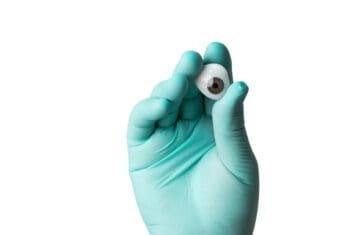Guide to Enucleation: What Happens When You Lose an Eye?
Home / Vision Education Center /
Last Updated:
Cancer, trauma, and other issues may indicate a need to remove one of your eyes. Your doctor will recommend either enucleation or evisceration to remove the problematic eye.
Table of Contents
Both procedures have similarities. Enucleation involves removing the entire eyeball but leaving the eye muscles and other orbital contents present. With evisceration, just the contents of the eye and cornea are removed; the sclera (white part of eye) remains.
Evisceration is considered the easier of the two, but not everyone qualifies for it. In many cases of infection or trauma, enucleation is usually the preferred method.
Once your eye is removed, your doctor will talk to you about prosthetic options. They will also provide instructions about how to care for the open eye socket.

Reasons for Eye Removal
Enucleation has been performed since the mid-1800s. Today, it is performed for multiple reasons.
- Retinoblastoma, uveal melanoma, or certain other cancers of the eye
- Painful, blind eye
- Microphthalmos (a disorder in which one or both eyes is abnormally small and malformed)
- Trauma
- Sympathetic ophthalmia (a unique type of inflammation that occurs after surgery or trauma to the eye)
You deserve clear vision. We can help.
With 135+ locations and over 2.5 million procedures performed, our board-certified eye surgeons deliver results you can trust. Your journey to better vision starts here.
Whether enucleation is right for cases of acute trauma remains controversial, especially when someone is unable to consent, or they have an altered mental status. When the above conditions are present, doctors typically seek out other possible treatments first.
Removing the eye is a treatment option that is typically only considered when all other possibilities have been exhausted.
Eye Removal Procedures
When unfortunate events lead to your doctor recommending eye removal, there are two primary ways to go about it: evisceration or enucleation.
These are both irreversible eye-removal procedures to treat conditions like ocular cancers, traumatic injury and other end-stage eye diseases, including diabetic retinopathy. A prosthesis inserted after the surgery gives you a nearly normal look but might also present with complications.
Evisceration vs. Enucleation
- Evisceration: In this process, the surgeon removes the contents of the eye and the clear dome-shaped part at the front of the eye (cornea). The procedure does not eliminate the eye muscles and the white part of the eye (scleral shell).
- Enucleation: This the more aggressive surgery. The surgeon removes the entire eye globe, leaving behind the eye muscles, which the doctor will attach to an artificial eyeball to aid eye movement.
Both of the surgeries leave patients with the same physical appearance in the face, but there are differences between the two. Evisceration is less invasive and takes less time to heal. It achieves the same results as enucleation, so it’s no surprise that this is the option most patients prefer.
However, it’s possible you won’t be eligible for an evisceration. If you have a severe eye condition such as infection, cancer or severe injury or trauma, doctors recommend enucleation as the better surgical treatment.
Let your ophthalmologist walk you through your options before settling down on one. They will point out the risks you need to consider when choosing one over the other.
What to Expect Before and During Surgery
Before you and your doctor map out your surgery, let the doctor know about all medications you’re taking, especially blood thinners.
Evisceration and enucleation are both outpatient procedures, and they each take about an hour to complete. You will want to arrange for someone to take you home since the anesthesia makes it dangerous to drive yourself.
Surgeons conduct evisceration and enucleation using numbing medicine (local anesthesia) with either sedation (medicine that helps you relax and sometimes puts you to sleep) or general anesthesia (medication that does put you to sleep). All are given in the operating room.
Once the surgeon removes the unneeded parts of the eye, they fill the empty socket with an implant. It can be made from a variety of materials. Most prevalent are acrylic, porous polyethylene and dermis fat.
If you have an enucleation, the surgeon will sew six of your eye muscles to the implant. If a scleral shell from a cadaver is available, the surgeon will wrap it around your new implant. The doctor will have pre-tested the cadaver tissue rigorously to eliminate the chances of disease transmission. (This part of the surgery is unnecessary with evisceration because the surgery leaves the muscles attached to your own scleral shell.)
Once that’s done, a temporary prosthetic (conformer) is placed over the implant. The clear acrylic conformer aids healing and keeps the eye’s shape before the final prosthetic fitting six to eight weeks after surgery.
If you’re having problems healing or keeping the conformer in place, the surgeon may sew your eyelid shut.
Finally, they will place a large pressure bandage or dressing over the eye to protect the wound, prevent bleeding, and reduce swelling and bruising after the surgery.
After Surgery
Most over-the-counter pain relief medicines are strong enough to keep any severe pain at bay, but in cases of extreme pain, your ophthalmologist may prescribe steroids or a stronger pain medication. If minor infections occur, they may prescribe antibiotics.
Your ophthalmologist will advise you to refrain from swimming and strenuous physical activity for at least two weeks after surgery. You should also avoid bending and lifting heavy objects for at least one month.
Schedule a follow-up exam a week after the surgery for the surgeon to inspect the healing process and check for any infections. The surgeon will remove the patch, and the usual mild bruising and swelling you see will improve over two weeks.
It may take up to two months before you’re well enough to have the fitting of an eye prosthetic by your ocularist.
You deserve clear vision. We can help.
With 135+ locations and over 2.5 million procedures performed, our board-certified eye surgeons deliver results you can trust. Your journey to better vision starts here.
Possible Complications of Eye Removal
Like any other surgery, eye removal procedures carry some risk. For instance, sympathetic ophthalmia might occur in the healthy eye following evisceration of the problematic one. Although uncommon, this inflammation can cause vision loss in the remaining eye if not treated adequately. Antibiotic eye drops or oral medications are enough for treating infections at the surgical site.
Other possible complications that you need to talk to your doctor about include bleeding, falling out of the implant and the need for additional surgeries.
Prosthetic Eyes

People can opt to have a custom prosthesis made so it looks like they still have an eye in the socket. Once it is ready and the doctor determines the conformer can come out, the prosthesis is put into place.
Prosthetic eyes are designed to look like your natural eye. The prosthesis manufacturer will work to make the eye color as close to your natural eye color as possible, so both eyes match.
There are different materials used to create prosthetic eyes. The materials that are used are compatible with the tissues present in the eye socket. Polymethyl methacrylate, a type of acrylic plastic polymer, is the most common glass eye material. It is resistant to shattering and lightweight.
In some cases, manufacturers opt to use a silicone polymer to create prosthetic eyes.
Some prosthetic implants can move, depending on the implant type the surgeon uses. Some of the newer prosthetic materials are porous, making it possible for blood vessels to grow into the muscles, tissues, and the implant itself.
When eye movement occurs, it is similar to the movement of your natural eye. The primary difference is that the pupil of the prosthetic does not change in size depending on the light level in your environment. However, the overall look is relatively natural compared to prosthetics from decades past.
You can choose to not use a prosthesis following eye removal. However, there will be more follow-up care to ensure the integrity of your eye socket.
Are Prosthetic Eyes Safe?
Having a prosthetic eye can significantly boost your confidence following eye removal since the prosthesis moves almost like the functional eye. While the prosthesis is easy to wear and maintain, sometimes it causes mild discomfort with discharge. To reduce the risk of infection, it is advisable to clean the artificial eye once in three months and go for professional polishing yearly.
Caring for Eye Health After Enucleation
Immediately following removal of your eye, you will have a pressure dressing. Your surgeon will provide you with details on how to care for this. In general, you cannot remove it until the surgeon does. This takes about a week.
Once the dressing is removed, you will be instructed to clean your face as usual. A prescription ointment is commonly prescribed that you will use about twice a day for a period of time specified by your surgeon. After the dressing comes off, you can usually shower as normal. However, for up to two weeks after the procedure, you are usually instructed to avoid going underwater.
It is possible for the conformer to fall out. If this happens, you should clean it according to your surgeon’s instructions and put it back into your eye. Inserting this device is similar to applying contact lenses. However, you can have a health care professional reinsert it if you are not comfortable doing so.
While it is not necessary, you can wear an eye patch during the time you are waiting for your prosthetic eye. You might choose this for cosmetic reasons, as there are no medical benefits. Some people opt for disposable patches, or you can purchase a reusable one.
Once you have your prosthetic, simply follow the instructions provided by your doctor. This typically consists of keeping the prosthetic clean and using the right technique to insert it.
Your doctor will schedule a variety of follow-up appointments after your procedure. It is imperative that you keep all of these, as they allow your doctor to assess how well your eye socket is healing. This is also when you will start working toward getting a prosthetic, if you choose to wear one.
You deserve clear vision. We can help.
With 135+ locations and over 2.5 million procedures performed, our board-certified eye surgeons deliver results you can trust. Your journey to better vision starts here.
References
- Enucleation. (May 2019). American Academy of Ophthalmology.
- Enucleation and Evisceration: What to Expect. (September 2018). University of Iowa Health Care.
- Eye Removal (Enucleation and Evisceration). American Society of Ophthalmic Plastic and Reconstructive Surgery.
- What to Expect After Your Enucleation Surgery. Memorial Sloan Kettering Cancer Center.
- Eye Removal Surgery: Enucleation and Evisceration. (November 20, 2019). American Academy of Ophthalmology.
- Eye Removal (Enucleation & Evisceration). (2021). American Society of Ophthalmic Plastic & Reconstructive Surgery.
- Surgical Procedures. (2017). American Society of Ocularists.
- Eye Removal Surgery: Enucleation and Evisceration. (November 2019). American Academy of Ophthalmology.
- Enucleation and Evisceration: What to Expect. (September 2018). University of Iowa Carver College of Medicine, Department of Ophthalmology & Visual Sciences.
- Eye Removal (Enucleation & Evisceration). (accessed October 2021). American Society of Ophthalmic Plastic & Reconstructive Surgery.
This content is for informational purposes only. It may have been reviewed by a licensed physician, but is not intended to serve as a substitute for professional medical advice. Always consult your healthcare provider with any health concerns. For more, read our Privacy Policy and Editorial Policy.